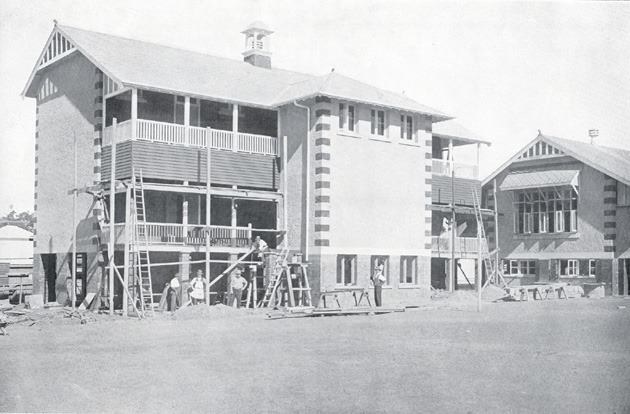 Wooloowin State School was built in four stages. The first section was constructed in 1914, with additions in 1918, 1925 and 1934. In 1914, Wooloowin State School was considered a model school at the forefront of progressive education in Queensland and this was reflected in the building, grounds, furniture, facilities, curriculum and staff. It was a modern school for a modern, rapidly expanding suburb.
Wooloowin State School was built in four stages. The first section was constructed in 1914, with additions in 1918, 1925 and 1934. In 1914, Wooloowin State School was considered a model school at the forefront of progressive education in Queensland and this was reflected in the building, grounds, furniture, facilities, curriculum and staff. It was a modern school for a modern, rapidly expanding suburb.
Originally part of Lutwyche, Wooloowin was named after the railway station (on the line to Northgate Junction) which was opened in November, 1889. The area had developed a suburban identity in the 1880s, when the larger estates were subdivided, but in the first half of the 20th century, particularly following the extension of the tramline along Lutwyche Road to Kedron in 1913 – 1914, Wooloowin really boomed as a residential working class suburb.
In 1911, the Wooloowin Progress Association was formed. Its first secretary was Mr William Alfred Jolly, later Mayor of Windsor, and in 1925, first Lord Mayor of Greater Brisbane. It was largely due to the work of the Wooloowin Progress Association, who formed a school building committee in October 1911, that the Wooloowin State School was established. Prior to 1914, Wooloowin children attended the overcrowded state schools at Eagle Junction and Bowen Bridge Road.
The Department of Public Instruction purchased Nolan’s Paddock, a three acre site on Lutwyche Road for £1 200 and the design for a new school for this site was prepared in the Government Architect’s Office of the Department of Works in 1913.
At a cost of £3 901, Wooloowin State School was the sixth most expensive Queensland Public Works contract let during the 1913-1914 financial year and was intended as a model or ‘show’ school. The foundation stone was laid early in 1914 by the Secretary of Public Instruction, the Hon J Blair (later Chief Justice Blair) and the school was opened on 15 September 1914 with 266 pupils. It comprised four large classrooms in two single storeyed brick wings, with 10 feet wide verandas front and back and head teacher’s room and staff room attached to the front wing. The new classrooms were furnished with the most modern two-student desks with tip-up seats, providing considerably more elbow room that the old forms and desks, and with large green ‘blackboards’ rather than the old board and easel. The staff for this model school was specially chosen from amongst Queensland’s finest state school teachers.
The Wooloowin State School building committee financed construction of a swimming pool, 42 feet long, 16 feet wide and 5 feet deep at the deepest end, in 1916. The pool was enlarged to its present size in 1925.
In 1918, woodwork and domestic science was added to the school curriculum, although no classrooms appear to have been designated specifically for these subjects. It is understood that Wooloowin was the first primary school to introduce these subjects, as provided for under the new syllabus provisions of 1915.
The first addition to the school was constructed in 1918. It was a brick building, with 10ft wide verandas; roughcast externally and roofed with asbestos slate, which mirrored the 1914 side wing. This brought the number of classrooms to six and was opened in September 1918. By 1921, school enrolment had grown to over 800 and in 1923, plans were prepared for a second addition, a two-storeyed stuccoed brick building with an asbestos slate roof, containing four classrooms on each floor and a veranda and a balcony on the north side. This building was erected in 1925 at a cost of £6 233 and opened in July that year.
In the 1920 and 1930s, Wooloowin continued to expand as a working class suburb. By the late 1930s, population pressure again necessitated additions to the Wooloowin State School and in 1934, a three-storeyed brick wing was constructed on the northern side of the site. It had a face brick and roughcast exterior, fibro cement slates to match existing buildings and 10ft wide verandas on each floor. Each of the upper floors had four classrooms and the lower storey contained purpose-equipped domestic science and manual training rooms. In the 1930s and 1940s, students from Windsor State School, further south along Lutwyche Road, attended woodwork and domestic science classes at Wooloowin State School’s new facilities.
The 1934 building was the last of the additions.
Heritage Register. 2013. Heritage Register. [ONLINE] Available at: https://heritage-register.ehp.qld.gov.au/placeDetail.html?siteId=16326. [Accessed 05 November 2013].
The Wooloowin State School motto, since 1914, has been 'Manners Maketh Man'.
Fire in 2003
On Sunday, 31 August 2003, the school was subject to an arson attack, which damaged the office, pre-school, tuckshop, School’s Out (Out of School Hours Program), and library. As the school was heritage-listed, the buildings could not be knocked down or raised but had to be carefully repaired. Two demountables were erected on the oval as replacement classrooms while the school was rebuilt. On 11 September 2004, at a cost of A$ 4 million, the school was officially reopened by Liddy Clark, MP. The main block, library and pre-school were totally re-furbished and a new tuckshop and uniform shop were built near the pool. School’s Out, originally located under the library, used one of the demountable classrooms originally used as temporary classrooms.